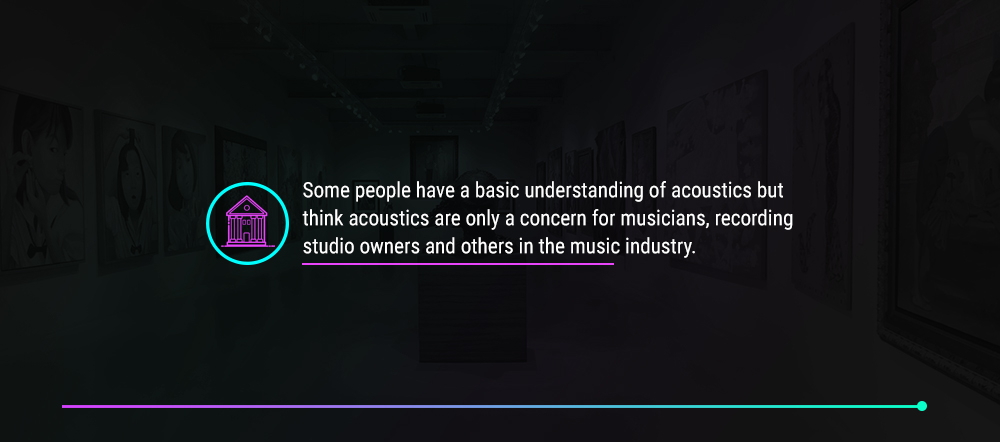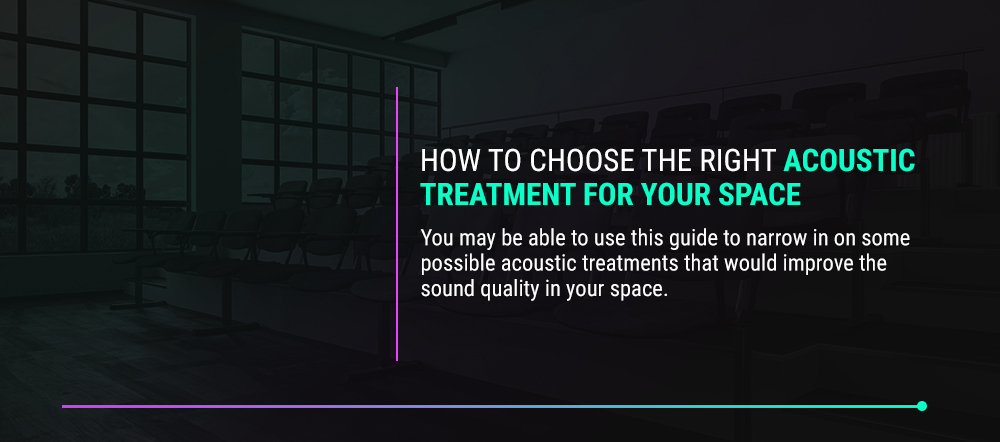

You’ve probably heard the term acoustics in reference to a theater or concert hall, but acoustics are an important aspect of every building you’ve ever stepped foot in. Have you considered what the acoustics are like at your business? For most spaces, the acoustics are less than ideal.
So, how do you improve the acoustics in a space? The answer is acoustic treatments. In this guide, we’ll discuss seven types of acoustic treatments you can use to improve the acoustics in your space.

Some people have a basic understanding of acoustics but think acoustics are only a concern for musicians, recording studio owners and others in the music industry. The reality is that acoustics should be an important concern for any facility, from offices to museums to retail stores. The concept of acoustic treatment is based on the fact that most spaces need some help to achieve better acoustics.
Maybe there are too many hard surfaces that deflect sound waves and allow them to reverberate throughout your facility, or maybe your walls allow sound to bleed over excessively from room to room. Whatever the case, these problems can negatively affect the atmosphere in a building and, in some cases, can cause some serious problems. Take a museum, for example. With poor acoustics, guests on a guided tour may struggle to hear the guide over the competing sounds of footsteps and conversations going on in the room.
Acoustic treatments are solutions that help to absorb or diffuse sound to improve the acoustic quality of a space. These treatments come in various forms, and some facilities may need multiple types of treatments to achieve the ideal acoustics for the space.
Acoustic treatment can help regulate three aspects of sound that can otherwise pose a problem. These include reflection, reverberation and resonance.
Reflection is a common problem in many rooms. When sound waves travel across a room, they will run into surfaces, such as walls, furniture or other objects. Certain types of surfaces will absorb sound waves. Others will cause sound waves to bounce off and continue traveling in a different direction.
This can especially cause a problem for school auditoriums, concert venues, churches and other spaces where you want to direct sound toward an audience or congregation. If the sound waves reflect off of other surfaces in their path, they can end up being deflected away from their target destination. Reflection can also lead to reverberation.
Reverberation is the problem that occurs when multiple sound waves bounce off of surfaces and congregate together. This is what causes some rooms to sound echoey. For instance, you’ve probably noticed that you hear more reverberation in a large, empty room than one full of people. That’s because when there are people in the room, sound waves are absorbed by encountering people’s clothing. When there is nothing but hard surfaces, however, sound waves will bounce around continuously.
Another issue with reverberation is that it causes a decay in sound quality. For example, if you want people to hear music or a speaker clearly, reverberation will interfere with that. Even in businesses like restaurants, though, reverberation can pose problems since it makes it difficult for diners to carry on a conversation over the loud, echoey sounds traveling throughout the room.
All the objects and materials in a room vibrate at a natural frequency. For instance, a window in a room may vibrate at a rate of 200 Hz. If a sound wave with a frequency of 200 Hz encounters the window surface, it will cause the window to vibrate more powerfully, and the sound will be amplified. This is the concept of resonance.
Resonance can create acoustic problems for facilities. Resonance causes sounds in a room to be “boomy,” a term sound engineers use to describe loud, distorted sounds. It can also cause feedback in sound systems.

There are several types of solutions that acoustics experts can use to address the problems of reflection, reverberation and resonance. Many facilities need a combination of these solutions to fully address their acoustic issues.
Low-frequency sound waves tend to be the most difficult to regulate because these waves are especially long and powerful. These sounds also collect in corners and make the bass sound in a room sound too loud. This is where bass traps come in. As the name suggests, these devices are designed to absorb or trap bass sounds at the corners of a room.
There are different types of bass traps you can install, depending on the acoustic issues you’re experiencing. Some traps are also effective at trapping mid and high frequencies. Bass traps are made from porous materials like rigid fiberglass and foam that effectively soak up sound waves in the corner of a room.
Acoustic panels are designed to absorb sound waves, just like bass traps. However, acoustic panels are thinner than bass traps, which means they won’t be as effective at trapping lower frequencies. They can still make a significant improvement, however, in spaces where reverberation is an issue. Rather than allowing sound waves to reflect off and travel throughout a room, acoustic panels absorb the sound. This can help a space sound far less echoey.
Whereas bass traps appear a bit more conspicuous, acoustic panels can blend in with a room’s decor. You can place acoustic panels anywhere in a room, typically along the walls. Some acoustic panels can even look like artwork on a wall, so people never even notice your acoustic treatments, even though they’re in full view.
Most acoustic panels are designed to be installed on walls, but some panels are specifically designed for ceilings. These panels, known as ceiling clouds, are lightweight panels that hang horizontally from the ceiling. Ceiling clouds are especially helpful in buildings with high ceilings. High ceilings can be an attractive architectural feature, but unfortunately, high ceilings can also contribute to excessive sound reverberation.
Ceiling clouds come in various materials and styles. Some are made from foam, others are made from metal, and some ceiling clouds are wrapped with fabric. You may have noticed a creative, modern-looking ceiling in a building before and didn’t even realize the suspended panels were primarily installed to improve the room’s acoustics.
Whereas bass traps, acoustic panels and ceiling clouds are designed to absorb sound, some acoustic treatments are instead designed to diffuse sound. Absorbing sound dampens the overall sound in the room. In some scenarios, you’ll want to keep sound waves from causing echo without fully absorbing the sound, so the room doesn’t end up sounding too quiet.
In these cases, diffuser panels are a helpful acoustic treatment. These panels are three-dimensional, with pieces that stick out to different degrees. The effect is that sound waves that hit the diffuser panel will scatter in random directions. So, while sound absorption treatments remove sound energy, which deadens sound, diffuser panels are an acoustic treatment that helps to keep a space sounding live. You can use diffuser panels as a complement to sound-absorbing treatments or in place of them.
Acoustic foam is similar to acoustic panels. In fact, many acoustic panels are made from foam. However, while acoustic panels come in a form that is ready to hang on the wall and has aesthetic appeal, acoustic foam comes in more of a raw material form. Acoustic foam is more commonly used in recording studios than in businesses that need acoustic treatment.
Whereas acoustic panels tend to be smooth, acoustic foam has a distinct egg crate-like surface. This is partly why acoustic foam is used for more practical, heavy-duty acoustic treatment as opposed to lighter treatments for spaces like restaurants or stores. You can place acoustic foam on walls and ceilings to help trap sound.
If you have an issue with sound bleeding from one room to the next in your facility, then you need to look for soundproofing solutions. Fiberglass insulation is a great option to consider. Adding insulation in walls can prevent sound from moving through them. Fiberglass insulation also works to absorb sound in the same way that bass traps, acoustic panels and ceiling clouds do, helping to prevent reverberation and other acoustic problems.
Thicker panels are better able to absorb the longer wavelengths of bass sound, but you can also install thinner panels of insulation with a gap between the insulation and the wall to help absorb lower frequencies. You can also install fiberglass insulation at a room’s corners to achieve the same effect as a bass trap.
If you’re dealing with an ongoing resonance issue, a possible solution is a Helmholtz resonator. This device is named after the German physicist who invented it. It is essentially a hollow sphere with a small opening that protrudes from the top, similar to a bottle or vase. The important thing to note for acoustic treatment is that Helmholtz resonators are able to absorb sound of a similar frequency to its own natural frequency.
You can use resonators of different sizes and shapes to absorb different frequencies. This allows you to target specific frequencies that are superfluous in a space. By absorbing these specific frequencies, you can neutralize the issue. Helmholtz resonators are not a popular means of general acoustic treatment, but they can come in handy in certain situations.

Since there are several options and a nearly infinite number of combinations out there that you could employ to acoustically treat your space, you may wonder how you can determine the correct treatment options for your space. First, it’s important to identify the problems your acoustic treatment should address. This depends on the space and how you want the acoustics in your space to sound. There isn’t a one-size-fits-all solution.
For example, reverberation can be a problem, but some facilities may want a longer reverberation time than others. This includes churches designed for singing and theaters where you want speech to be clear, for instance. Similarly, some bars or restaurants may want to encourage a noisy atmosphere while others may want to eliminate noise so diners can enjoy a peaceful evening of conversation.
You may be able to use this guide to narrow in on some possible acoustic treatments that would improve the sound quality in your space. It’s ultimately best, however, to rely on professionals like the ones at Illuminated Integration who understand the complexities of acoustics and can diagnose the acoustic problems in your space before offering perfectly tailored solutions.
Otherwise, you’ll likely find yourself going through a great deal of trial and error, and incurring expenses along the way, until your experimentation finally results in the acoustic quality you’ve been after. Hiring a professional can allow you to skip over that time, expense and frustration and help you address your acoustic problems in a clear and direct way. You may just need one simple solution, or you may benefit from a combination of acoustic treatments.
Once you’ve found the ideal acoustics for your space, you’ll notice a real difference in the atmosphere. Whether it’s an office, school, museum, store, or any other facility, every person in your building can benefit from the right acoustic treatment in the space.

As we’ve seen, acoustics can be a complex thing with a range of solutions to address various problems. When you’re not sure the best way to improve your facility’s acoustics, you can trust the experts at Illuminated Integration. Our acoustic consultants can determine what your space needs and design the best solutions for you. Then, our team can install your acoustics system according to the design we’ve shared with you.
If you have any questions about acoustic treatments or would like to learn more about how Illuminated Integration can help with all of your audio, video and lighting (AVL) needs, contact us today. We would be happy to provide some guidance and tell you more about our valuable AVL services.